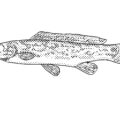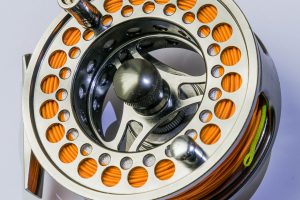The answer to this question is both yes and no. Mudfish, also known as bowfins, are a type of fish that have a primitive lung-like organ called a gas bladder. This gas bladder is lined with blood vessels that allow the fish to extract oxygen from the air. However, this organ is not used for respiration as much as it is used for buoyancy control. Mudfish primarily rely on their gills for breathing, but they can use their gas bladder as a supplementary breathing organ in low-oxygen environments.
Despite this unique adaptation, mudfish are not the only fish that can breathe air. Other fish, such as lungfish, catfish, and eels, can also extract oxygen from the air. However, mudfish are unique in that they can survive in a wide range of environments, including stagnant and low-oxygen waters, thanks to their ability to breathe air through their skin and gas bladder.
Understanding Mudfish
Mudfish, also known as Bowfin, are a primitive species of freshwater fish that belong to the family Amiidae. They are found in various regions worldwide, including Asia, Africa, South America, and North America.
Mudfish are long-lived and considered living fossils, having existed for over 100 million years. They are also known as dipnoi, which means they have both gills and lungs. However, mudfish use their gills to breathe underwater and only use their lungs in oxygen-deprived environments.
There are several mudfish species, the most common being the Amia calva, found in North America, and the Amia anguilla, located in South America. Mudfish can vary in size, with some species growing up to 1 meter in length and weighing up to 9 kilograms.
Mudfish are eukaryotic animals that belong to the phylum Chordata. They are known for their hardy nature and ability to survive in low-oxygen environments. Mudfish are also popular among anglers due to their aggressive behavior and hard fight when caught.
In conclusion, mudfish are a fascinating species of freshwater fish that have adapted to survive in various environments. Their ability to breathe underwater and in the air makes them a unique and engaging species to study.
Anatomy of Mudfish
Mudfish, also known as Bowfin, are freshwater fish in North America. They are known for their unique anatomy, which has evolved over millions of years to suit their environment. This section will discuss the respiratory system, skeletal features, and external features of mudfish.
Respiratory System
Mudfish have a primitive lung, which allows them to gulp air at the water’s surface. They also have gills, which are used for gas exchange underwater. The nostrils of mudfish are located on the upper part of their head, and they use them to inhale air. The pulmonary artery and vein transport blood to and from the lung.
Skeletal Features
The skull of mudfish is heavily armored, which protects their brain and other vital organs. Mudfish have a long, cylindrical body with a tapered tail. They have pectoral and pelvic fins used for maneuvering in the water. The dorsal fin of mudfish is located towards the back of their body, and it helps them maintain stability. The caudal fin, also known as the tail fin, is used for propulsion.
External Features
Mudfish have bright green scales with a mottled pattern. They have a lower jaw that protrudes beyond the upper jaw, which allows them to catch prey more easily. The mudfish scales are cycloid, meaning they have a smooth outer edge. Mudfish have paired fins, including the pectoral and pelvic fins used for swimming and maneuvering. They also have an anal fin, which is located on the underside of their body.
In conclusion, mudfish have a unique anatomy that has evolved over millions of years to suit their environment. Their respiratory system allows them to gulp air at the water’s surface, and they have a heavily armored skull to protect their brain and other vital organs. Mudfish have bright green scales with a mottled pattern and paired fins for swimming and maneuvering in the water.
Adaptations and Survival Strategies
Estivation
Mudfish are known for their ability to survive in harsh environments, and one of their most impressive adaptations is estivation. During drought or when water levels are low, mudfish burrow into the mud and enter a state of dormancy. They reduce their metabolic rate and produce urea to conserve water. When conditions improve, they emerge from their tunnels and resume normal activities.
Air Breathing
Mudfish can breathe air, an essential adaptation for survival in stagnant or oxygen-depleted water. They can extract oxygen from the air using their swim bladder, which acts as a primitive lung. Mudfish also have specialized blood vessels that absorb oxygen directly from the water’s surface.
Aquatic Adaptations
Mudfish are well adapted to life in freshwater environments. Their streamlined body shape and powerful tail allow them to swim efficiently. Mudfish also have a gas bladder that helps them control their buoyancy and maintain their position in the water column.
Predator Avoidance
Mudfish are preyed upon by various predators, including birds, mammals, and larger fish. To avoid detection, mudfish often remain motionless on the bottom of the water or hide among vegetation. Mudfish can also change their coloration to blend in with their surroundings, which helps them avoid detection by predators.
Overall, mudfish have a range of adaptations and survival strategies that allow them to thrive in various environments. Their ability to estivate, breathe air, and adapt to aquatic environments makes them fascinating to study.
Habitat and Ecology
Mudfish are freshwater fish that inhabit swamps, rivers, and other shallow water bodies with slow-moving or stagnant water. They adapt well to their habitat and can survive in water with low oxygen levels.
Mudfish are omnivorous and feed on various food sources, including insects, crustaceans, and small fish. They also consume plant matter, such as algae and aquatic plants.
The ecology of mudfish is closely tied to their habitat. They are an essential part of the food chain in their ecosystem, serving as both predator and prey. Mudfish are also known to play a role in nutrient cycling, as they consume and excrete organic matter, which can contribute to the growth of aquatic plants.
Overall, mudfish are a fascinating and important species in freshwater ecosystems. Their ability to adapt to their environment and their role in the food chain makes them a valuable part of the ecosystem.
Evolutionary History
Mudfish, also known as Lungfish, are a type of fish that belong to the subclass Dipnoi. This subclass is part of the larger group of fish known as Sarcopterygii, which includes tetrapods such as amphibians, reptiles, birds, and mammals.
The evolutionary history of mudfish dates back to the Devonian period, around 416 million years ago. During this time, the first tetrapods evolved from Sarcopterygian fish. Mudfish share many characteristics with these early tetrapods, including the presence of lungs.
Mudfish are not the only fish that have lungs. Other examples include the mudskipper, a type of amphibious fish that can breathe air and move on land, and the Lungfish, which is found in Africa, South America, and Australia.
Despite their name, mudfish do not have true lungs like mammals do. Instead, they have a modified swim bladder that acts as a lung. This allows them to breathe air when oxygen levels in the water are low.
In terms of their evolutionary history, mudfish are more closely related to amphibians than other fish. This is because they share many characteristics with amphibians, including the ability to breathe air and the presence of limbs.
In conclusion, the evolutionary history of mudfish is closely tied to the evolution of tetrapods and the transition from fish to land-dwelling animals. While they are not the only fish to have lungs, they are a unique and vital part of the evolutionary history of vertebrates.
Notable Species
Protopterus
Protopterus is a genus of Lungfish found in Africa. They are known for their ability to survive in harsh environments, such as droughts. They are also known for their ability to aestivate, a form of hibernation that allows them to survive prolonged periods of drought. Protopterus have a unique respiratory system that will enable them to breathe air directly, making them one of the few known species of fish that can do so.
Lepidosiren Paradoxa
Lepidosiren Paradoxa, also known as the South American Lungfish, is found in the Amazon River Basin. They are known for their ability to breathe air through a modified swim bladder, which acts as a lung. They are also known for their long lifespan, with some individuals living up to 20 years. Lepidosiren Paradoxa is also able to aestivate during droughts, much like Protopterus.
Neoceratodus Forsteri
Neoceratodus Forsteri, also known as the Australian Lungfish, is found in Australia. They are one of only six extant species of Lungfish in the world. Their unique respiratory system allows them to breathe air through a modified swim bladder. They are also known for their long lifespan, with some individuals living up to 100 years.
Amia Calva
Amia Calva, also known as the Bowfin, is a fish found in North America. They are not true Lungfish, but they have a modified swim bladder that allows them to breathe air. They are also known for their hardiness and can survive in low-oxygen environments. Amia Calva are also known for their aggressive behavior and sharp teeth.

South American Lungfish
The South American Lungfish, known as Lepidosiren Paradoxa, is found in the Amazon River Basin. They are known for their ability to breathe air through a modified swim bladder, which acts as a lung. They are also known for their long lifespan, with some individuals living up to 20 years. Lepidosiren Paradoxa is also able to aestivate during droughts, much like Protopterus.
Conservation Status
The conservation status of mudfish varies depending on the species. Some species are classified as “Least Concern” by the International Union for Conservation of Nature (IUCN), while others are considered “Endangered” or “Critically Endangered.”
For example, the Lake Oku mudfish (Paramormyrops sp. nov. ‘Oku’) is listed as “Critically Endangered” due to habitat loss and degradation caused by human activities such as logging, agriculture, and the construction of dams. The IUCN also notes that the species has a restricted range and low population size.
On the other hand, the African Lungfish (Protopterus annectens) is classified as “Least Concern” due to its wide distribution across Africa and its ability to adapt to various habitats, including temporary pools and rivers that dry up periodically.
Overall, the conservation status of mudfish highlights the importance of protecting freshwater habitats and reducing human impacts on aquatic ecosystems. Efforts to conserve these species can include habitat restoration, fishing and other human activities regulation, and captive breeding programs to help maintain genetic diversity and prevent extinction.
Mudfish in Human Culture
Mudfish have been an essential part of human culture for centuries. They are often used as a food source in many countries, including India and Quebec. In Europe, mudfish are sometimes kept in aquariums as pets due to their unique appearance and behavior.
In India, mudfish are considered a delicacy and are often used in traditional dishes. They are also used in Ayurvedic medicine for their supposed healing properties. In Quebec, mudfish are popular in traditional dishes such as poutine.
In Europe, mudfish are sometimes kept in aquariums due to their interesting behavior. They are known for their ability to survive in low-oxygen environments, which makes them a popular choice for aquarium enthusiasts. Mudfish are also sometimes used in scientific research to study their unique respiratory system.
Overall, mudfish have played an essential role in human culture throughout history. Whether as a food source, a pet, or a subject of scientific research, these unique fish continue to fascinate and intrigue people worldwide.
Genetic Research and Discovery
Recent genetic research has shed light on the respiratory system of mudfish and whether or not they have lungs. Mudfish belong to the family of air-breathing fish, known for their ability to extract oxygen from air using specialized respiratory organs.
Studies have shown that mudfish do not have true lungs but rather a modified swim bladder that functions as a respiratory organ. The swim bladder of mudfish has evolved to extract oxygen from the air and is lined with a rich network of blood vessels that facilitate gas exchange.
The genome of mudfish has also been extensively studied to understand the genetic basis of their respiratory system. The genome of mudfish has revealed several genes involved in the development and function of the swim bladder, including genes that regulate the formation of blood vessels and genes that control the expression of oxygen-binding proteins.
Further research is needed to fully understand the genetic mechanisms underlying mudfish’s respiratory system. However, the current findings suggest that mudfish have evolved a unique respiratory system that allows them to thrive in environments with low oxygen levels.
In summary, genetic research has provided valuable insights into the respiratory system of mudfish, revealing the unique adaptations that have allowed them to survive in challenging environments.











